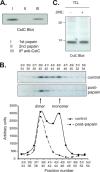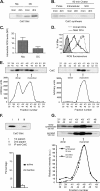Developmental regulation of synthesis and dimerization of the amyloidogenic protease inhibitor cystatin C in the hematopoietic system
- PMID: 24570004
- PMCID: PMC3975020
- DOI: 10.1074/jbc.M113.538041
Developmental regulation of synthesis and dimerization of the amyloidogenic protease inhibitor cystatin C in the hematopoietic system
Abstract
The cysteine protease inhibitor cystatin C is thought to be secreted by most cells and eliminated in the kidneys, so its concentration in plasma is diagnostic of kidney function. Low extracellular cystatin C is linked to pathologic protease activity in cancer, arthritis, atherosclerosis, aortic aneurism, and emphysema. Cystatin C forms non-inhibitory dimers and aggregates by a mechanism known as domain swapping, a property that reportedly protects against Alzheimer disease but can also cause amyloid angiopathy. Despite these clinical associations, little is known about the regulation of cystatin C production, dimerization, and secretion. We show that hematopoietic cells are major contributors to extracellular cystatin C levels in healthy mice. Among these cells, macrophages and dendritic cells (DC) are the predominant producers of cystatin C. Both cell types synthesize monomeric and dimeric cystatin C in vivo, but only secrete monomer. Dimerization occurs co-translationally in the endoplasmic reticulum and is regulated by the levels of reactive oxygen species (ROS) derived from mitochondria. Drugs or stimuli that reduce the intracellular concentration of ROS inhibit cystatin C dimerization. The extracellular concentration of inhibitory cystatin C is thus partly dependent on the abundance of macrophages and DC, and the ROS levels. These results have implications for the diagnostic use of serum cystatin C as a marker of kidney function during inflammatory processes that induce changes in DC or macrophage abundance. They also suggest an important role for macrophages, DC, and ROS in diseases associated with the protease inhibitory activity or amyloidogenic properties of cystatin C.
Keywords: Amyloidosis; Dendritic Cells; Macrophages; Protease Inhibitor; Protein Folding; Reactive Oxygen Species (ROS); Vascular Angiopathy.
Figures





Similar articles
-
Human cystatin C forms an inactive dimer during intracellular trafficking in transfected CHO cells.J Cell Physiol. 1997 Dec;173(3):423-32. doi: 10.1002/(SICI)1097-4652(199712)173:3<423::AID-JCP15>3.0.CO;2-C. J Cell Physiol. 1997. PMID: 9369956
-
Cellular processing of the amyloidogenic cystatin C variant of hereditary cerebral hemorrhage with amyloidosis, Icelandic type.Amyloid. 1999 Sep;6(3):172-82. doi: 10.3109/13506129909007323. Amyloid. 1999. PMID: 10524281
-
Human cystatin C, an amyloidogenic protein, dimerizes through three-dimensional domain swapping.Nat Struct Biol. 2001 Apr;8(4):316-20. doi: 10.1038/86188. Nat Struct Biol. 2001. PMID: 11276250
-
Molecular basis for amyloidosis related to hereditary brain hemorrhage.Scand J Clin Lab Invest Suppl. 1996;226:47-56. Scand J Clin Lab Invest Suppl. 1996. PMID: 8981667 Review.
-
Human cystatin C monomer, dimer, oligomer, and amyloid structures are related to health and disease.FEBS Lett. 2016 Dec;590(23):4192-4201. doi: 10.1002/1873-3468.12463. Epub 2016 Nov 2. FEBS Lett. 2016. PMID: 27766618 Review.
Cited by
-
Cystatin C regulates the cytotoxicity of infection-induced endothelial-derived β-amyloid.FEBS Open Bio. 2020 Nov;10(11):2464-2477. doi: 10.1002/2211-5463.12997. Epub 2020 Oct 25. FEBS Open Bio. 2020. PMID: 33030263 Free PMC article.
-
pH-dependent and dynamic interactions of cystatin C with heparan sulfate.Commun Biol. 2021 Feb 12;4(1):198. doi: 10.1038/s42003-021-01737-7. Commun Biol. 2021. PMID: 33580179 Free PMC article.
-
Cathepsin B in programmed cell death machinery: mechanisms of execution and regulatory pathways.Cell Death Dis. 2023 Apr 8;14(4):255. doi: 10.1038/s41419-023-05786-0. Cell Death Dis. 2023. PMID: 37031185 Free PMC article. Review.
-
Insights into the mechanism of cystatin C oligomer and amyloid formation and its interaction with β-amyloid.J Biol Chem. 2017 Jul 7;292(27):11485-11498. doi: 10.1074/jbc.M117.786558. Epub 2017 May 9. J Biol Chem. 2017. PMID: 28487367 Free PMC article.
-
Type 2 Cystatins and Their Roles in the Regulation of Human Immune Response and Cancer Progression.Cancers (Basel). 2023 Nov 10;15(22):5363. doi: 10.3390/cancers15225363. Cancers (Basel). 2023. PMID: 38001623 Free PMC article. Review.
References
-
- Abrahamson M., Alvarez-Fernandez M., Nathanson C. M. (2003) Cystatins. Biochem. Soc. Symp. 70, 179–199 - PubMed
-
- Keppler D. (2006) Towards novel anti-cancer strategies based on cystatin function. Cancer Lett 235, 159–176 - PubMed
-
- Liu J., Sukhova G. K., Sun J. S., Xu W. H., Libby P., Shi G. P. (2004) Lysosomal cysteine proteases in atherosclerosis. Arterioscler. Thromb. Vasc. Biol. 24, 1359–1366 - PubMed
-
- Rokadia H. K., Agarwal S. (2012) Serum cystatin C and emphysema: results from the National Health and Nutrition Examination Survey (NHANES). Lung 190, 283–290 - PubMed
Publication types
MeSH terms
Substances
LinkOut - more resources
Full Text Sources
Other Literature Sources
Medical

